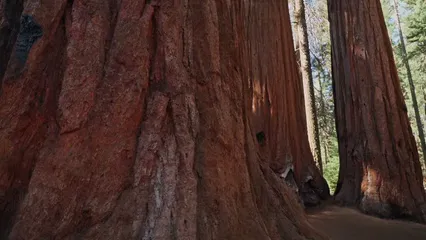
Why Don’t Redwoods Grow on the East Coast?
Introduction
Coast redwoods (Sequoia sempervirens) are iconic trees. They are known for their towering heights and unique ecosystems. You might wonder why these majestic giants don’t thrive on the East Coast. What keeps them rooted in the West? In this section, we’ll examine the ecological, climatic, and historical reasons behind their limited geographical range.
Speaking of trees, if you’re planning to cultivate your very own forest, you might want to start with some Coast Redwood Seeds. They’re a fantastic way to kickstart your gardening journey and bring a piece of California to your backyard!

Summary and Overview
The coast redwood’s native habitat stretches along the Pacific Coast. Here, they flourish in a unique blend of climate and geography. We will discuss their specific climate needs, soil preferences, and historical distribution. Understanding these elements is crucial for conservation efforts and gardening practices.
To ensure your gardening efforts are fruitful, consider investing in a reliable Gardening Tools Set. A good set can make all the difference when digging, planting, or weeding!

The Ideal Climate for Redwoods
Coastal Temperatures and Moisture Levels
Redwoods require specific temperature ranges to flourish. They thrive in moderate temperatures, generally between 40°F and 70°F. This consistency helps them maintain healthy growth. Coastal fog plays a vital role in moisture retention, delivering water during dry spells.
In California, average annual rainfall often reaches 50 to 100 inches, accompanied by frequent fog. In contrast, the East Coast experiences more extreme weather variations. Average annual rainfall varies but often falls short of redwood needs.
Understanding these temperature requirements is essential for planting decisions. If you’re looking to plant trees, consider your local climate carefully. You might also want to check out a Tree Planting Guide Book to help you navigate your planting journey!

Rainfall Patterns and Their Impact
Redwoods need substantial rainfall—between 75 and 100 inches annually. In California, consistent rainfall supports their growth. However, the East Coast averages about 40 to 50 inches a year. This difference creates a significant challenge for redwood survival.
Seasonal rainfall distribution matters too. In their native habitat, redwoods enjoy steady moisture throughout the year. Drought conditions can severely impact redwood growth, leading to stunted development. Consistent moisture is key for these trees to thrive. To keep track of moisture levels in your garden, a Rain Gauge could be a handy tool!
Before planting, check your local rainfall data. It’s crucial to understand how much water your area gets, as this will influence your gardening choices.

Soil Conditions and Redwoods
Soil Type and Drainage
Redwoods thrive in well-drained, rich soils. These soils allow water to flow freely, preventing root rot. Unfortunately, this soil type is uncommon on the East Coast. Instead, many areas have clay or compacted soils, which retain water and hinder drainage.
Clay soils can create a swampy environment. This saturation weakens the roots. Redwoods need aerated soil to support their extensive root systems. In California, soils are often sandy or loamy, providing the necessary drainage. For instance, about 60% of California’s soil is sandy, while the East Coast primarily features clay-rich soils.
Soil composition affects root health significantly. Without proper drainage, roots can suffocate. If you’re considering planting redwoods, test your soil first. Understanding the drainage capabilities will inform your planting decisions. A Soil Testing Kit can help you get started!

Nutrient Requirements
Redwoods have specific nutrient needs. They particularly thrive on nitrogen and organic matter. In their native habitat, surrounding vegetation helps cycle nutrients effectively. This cycle supports robust growth and health.
On the East Coast, many soils lack adequate nitrogen. The absence of rich organic matter can lead to nutrient deficiencies. Studies show that California soils often contain 2-3% organic matter, while East Coast soils may only have 1%. This difference can stunt redwood growth.
To improve soil health, consider adding organic amendments. Organic Compost or manure can enhance nutrient levels. If you want to attempt planting redwoods, address these nutrient deficiencies first. Proper soil preparation can make a significant difference in growth potential.

Historical Distribution of Redwoods
Ancient Forest Distribution
Historically, coast redwoods had a broader range. Fossil records indicate they grew across North America during warmer, wetter periods. Climate changes, particularly glacial and interglacial cycles, have shifted their habitats.
During glacial periods, redwoods retreated to the Pacific Coast. Warmer climates supported their growth in diverse regions. However, as the climate cooled, their range narrowed significantly. Today, most redwoods are found in California.
Climate data shows that redwoods thrived in milder conditions. Understanding this historical distribution highlights the impact of climate change on these trees. To learn more about the past, explore local ecology. History shapes our understanding of these magnificent trees and their environments.
Human Impact and Land Development
Human activities have significantly shaped landscapes. On the East Coast, urban development has transformed many natural spaces. Cities expand and forests shrink. This change limits habitats suitable for coast redwoods. Over the years, land use has shifted towards agriculture and housing. These developments often replace vital ecosystems that could support diverse species.
Historical logging practices also played a role. While redwoods thrive in their native habitats, excessive logging in the past devastated many forests. This logging severely impacted redwood habitats, reducing their numbers. In fact, only about 5% of the original ancient redwood forest remains.
Statistics reveal alarming trends. According to various studies, deforestation rates in the U.S. have led to the loss of millions of acres of forest annually. Urban sprawl, especially on the East Coast, continues to threaten remaining green spaces.
Understanding these impacts is crucial. Promoting responsible land use and conservation can help protect what’s left. Every effort counts in preserving our natural heritage. It’s essential to advocate for sustainable practices in urban development and support organizations focused on conservation. Together, we can make a difference and ensure future generations can enjoy redwoods and their ecosystems.

Conclusion
Redwoods do not grow on the East Coast for several reasons. First, their specific climate needs aren’t met. Redwoods thrive in moderate temperatures and require substantial moisture, often supplied by coastal fog. The East Coast experiences more extreme weather, lacking the consistent moisture redwoods need to flourish.
Second, soil conditions play a crucial role. Redwoods prefer well-drained, rich soils, which are rare in many Eastern landscapes. The clay-rich soils found there can hinder root development and lead to waterlogged conditions.
Lastly, historical factors have shaped redwood distribution. Climate changes over millennia reduced their range. Urban development has further limited suitable habitats on the East Coast.
Understanding these ecological requirements is vital for conservation efforts and gardening choices. While redwoods may not thrive in your backyard, many other beautiful trees suit East Coast conditions. Consider planting native species that provide beauty and support local ecosystems. And if you’re looking for a little extra help in the garden, a pair of Gardening Gloves can keep your hands clean and protected!

FAQs
Can redwoods grow in other parts of the United States?
Yes, redwoods can grow outside their native habitat. They thrive in hardiness zones 7 through 9, primarily in coastal areas. However, they require special care in regions with more extreme weather conditions.
What are the best trees to plant on the East Coast instead of redwoods?
Consider planting trees like the Dawn Redwood, Bald Cypress, or Eastern Hemlock. These species adapt well to East Coast conditions and provide similar aesthetic benefits. They can thrive in various soil types and moisture levels.
How can I create a suitable environment for growing redwoods?
To create a suitable environment, focus on microclimates. Plant redwoods in areas with partial shade and well-drained soil. Enhance soil with organic matter and ensure consistent watering, especially during dry spells. Proper care can improve their chances of thriving.
Are there any conservation efforts for redwoods outside California?
Yes, there are several conservation projects aimed at protecting redwoods outside their native habitat. Organizations like Save the Redwoods League and the Sempervirens Fund work tirelessly to preserve existing redwood forests. They focus on acquiring land, restoring habitats, and working with local communities. You can get involved in various ways. Consider volunteering for tree planting events or participating in educational programs. Donations to these organizations also help fund vital conservation efforts. Additionally, local parks sometimes host workshops on redwood care, allowing you to learn and share knowledge with others. By joining these initiatives, you can play a role in preserving these majestic trees for future generations.
What is the lifespan of a coast redwood?
Coast redwoods are among the longest-living trees on Earth. They can live over 2,000 years, with some individuals even exceeding this age. Their remarkable longevity is partly due to their thick bark, which protects against pests and diseases. Growth rates vary based on conditions. In ideal environments, a coast redwood can grow 2-3 feet annually. However, during stressful periods, growth can slow significantly. A healthy redwood can reach heights of over 300 feet, making it one of the tallest living organisms on the planet. Understanding their lifespan is critical for conservation. Protecting these ancient trees ensures that they continue to thrive and support the ecosystems they inhabit.
And while you’re at it, don’t forget to grab a Gardening Apron to keep all your tools handy while you work your green magic!
Please let us know what you think about our content by leaving a comment down below!
Thank you for reading till here 🙂
All images from Pexels




